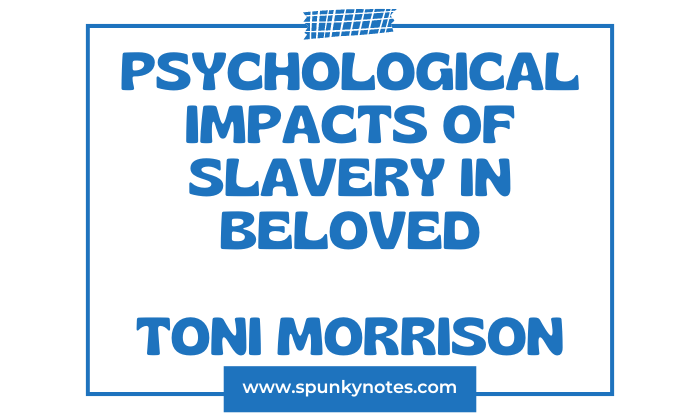

Estimated Reading Time: 8 min
Q. How does Morrison portray the physical and psychological impacts of slavery on the characters in Beloved?
Psychological Impacts of Slavery in Beloved
Toni Morrison’s Beloved presents slavery as a brutal system that destroys lives. The novel shows the pain and suffering of enslaved people through the story of Sethe and her family.
Morrison describes the physical violence, emotional trauma, and lasting effects of slavery on individuals and their families.
Slavery in Beloved takes away the dignity of the enslaved. The characters experience cruel treatment that reduces them to property. Sethe, the main character, escapes from Sweet Home, a plantation where she suffers abuse.
Her journey to freedom is difficult, and even after she reaches Ohio, she cannot escape the memories of her past. Paul D, another former slave, also carries the burden of his past. He remembers the harsh punishments, the chains, and the ways enslavers treated people like animals.
The novel also highlights how slavery destroys family bonds. Sethe’s children are in danger because slave owners believe they have the right to take them away. This fear pushes Sethe to make a terrible decision.
She kills her daughter rather than let her be taken back into slavery. This act shows how slavery forces people into impossible situations. Slavery does not just take away physical freedom; it also forces people to make choices that haunt them forever.
Psychological and Physical Impact on Characters
Morrison also shows how slavery prevents people from forming their own identity. The enslaved have no control over their names, their homes, or their futures.
Paul D spends years traveling from one place to another, trying to find a place where he belongs.n. He struggles with the belief that he is not a real man because slavery denied him the chance to make his own choices.
Baby Suggs, Sethe’s mother-in-law, tries to help others find their worth after slavery. She tells them to love their own bodies because slavery taught them to hate themselves. Even after gaining freedom, the characters in Beloved cannot escape the effects of slavery.
Their past continues to haunt them. The ghost of Sethe’s daughter, Beloved, is a reminder of what slavery took from her. Beloved represents the pain of the past that refuses to be forgotten.
She forces Sethe and Denver to confront their history. Morrison shows that slavery does not end with physical freedom. The trauma remains, affecting the lives of former slaves and their children.
Characters often show signs of trauma, including nightmares, fear, and an ongoing sense of loss. This trauma affects how they interact with others and how they see themselves, often causing difficulties in forming trusting relationships or maintaining a stable sense of self.
Physically, the harsh realities of slavery are evident in Morrison’s characters, who may bear scars or have endured brutal physical treatment.
Sethe
Physical Effects
Sethe escaped slavery, but she cannot escape what she has lived through. At Sweet Home, the plantation where she was enslaved, she was treated with extreme cruelty.
A severe whipping left a tree-shaped scar on her back, which a young white girl, Amy Denver, describes as a “chokecherry tree.” This scar is a permanent reminder of the suffering she endured.
Slavery in Beloved also includes sexual violence. Sethe experiences assault at the hands of a schoolteacher’s men. She remembers how they stole her milk, which was meant for her baby.
This moment shows how enslavers not only control people’s bodies but also take away their ability to care for their children. This deep violation stays with Sethe throughout her life. It affects the way she sees herself and the way she connects with others.
Psychological Effects
The psychological effects of slavery on Sethe are profound and pervasive. Haunted by the trauma of her past, Sethe lives in a state of constant alertness and deep fear that her former enslavers might come to reclaim her and her children.
This fear drives her to make a desperate decision to kill her daughter, Beloved, to spare her the horrors of slavery—a choice that leaves her with a burden of guilt and grief.
Sethe’s guilt takes a physical form in the presence of Beloved, the ghost of her deceased child. The spirit lingers in her home, forcing her to confront the pain she has tried to suppress.
As Beloved’s influence grows, Sethe loses herself in her sorrow and becomes consumed by the past. She struggles to separate what is real from what she fears and remembers, showing how trauma can control a person’s life.
Sethe’s mental state is further complicated by the arrival of Beloved’s ghost, who returns not only as a spectral presence but also as a reincarnation of her daughter in physical form.
This haunting is both literal and metaphorical, representing the way past traumas continue to intrude on the present. Sethe’s interactions with Beloved force her to confront her past, leading to moments of intense psychological turmoil as she relives her traumatic memories.
Paul D
Physical Effects
Paul D, a character in Toni Morrison’s “Beloved,” bears the physical scars of slavery much like Sethe, though he is less visible.
His most harrowing physical experience of slavery includes the forced wearing of an iron bit in his mouth, a cruel device used to silence and dehumanize him.
This degrading treatment is symbolic of the physical control and abuse inflicted upon enslaved people. Paul D also endured the brutality of labour in a chain gang, which left him with long-lasting physical ailments and pains that he carries into his life post-slavery.
Psychological Effects
The psychological effects of slavery on Paul D are deep and enduring. His experiences have instilled in him a profound sense of confinement and emasculation, which manifest in his often guarded and volatile emotional expressions.
Paul D struggles with feelings of unworthiness and a deep-seated fear of forming attachments. He describes keeping his worst memories locked inside a “tobacco tin buried in his chest where a red heart used to be,” where he compartmentalizes his traumatic memories to cope with everyday life.
When Paul D arrives at 124 Bluestone Road, he begins to reconnect with Sethe. However, the presence of Beloved unsettles him. She forces him to confront memories he had long kept buried.
The “tin” in his chest is broken open, making him feel the pain he has ignored for so long. At first, he runs away, unable to handle the weight of these emotions.
But in the end, he chooses to return to Sethe, recognizing that healing is possible if he allows himself to feel again.
By staying with Sethe, Paul D takes an important step toward recovering from his past. He encourages Sethe to see herself as worthy of love and to move forward instead of being trapped by what she has lost.
Through him, Morrison shows how emotional wounds cannot simply be ignored—they must be faced to heal.
Denver
Denver, Sethe’s youngest daughter, was born during her mother’s escape. She never experienced slavery firsthand, but it still affects her life. She grows up in a house haunted by her sister’s spirit, knowing that her mother killed her in an act of desperation.
Denver is isolated and afraid, rarely stepping beyond the yard of 124 Bluestone Road. Much of her fear comes from Sethe’s warnings about the dangers of the outside world.
Denver often retreats to a place she calls her “emerald closet,” a quiet area in the bushes where she feels safe. At first, she is happy to have Beloved in the house, seeing her as a companion.
However, she soon realizes that Beloved is taking control of Sethe’s life. As her mother becomes weaker and more withdrawn, Denver understands that she must act.
Baby Suggs
Baby Suggs, a character in Toni Morrison’s “Beloved,” experiences severe physical and psychological effects from her years in slavery. As Sethe’s mother-in-law, she provides love and guidance to those around her, especially to Sethe and Denver.
Physically, years of forced labour have left her body worn and weak. After gaining her freedom, her health continues to decline, showing how deeply slavery impacted her physically.
Her only remaining son, Halle, works to buy her freedom. She is grateful, but it hurts to know he is still enslaved. Later, he breaks under the weight of his suffering. She never sees him again. This leaves her with even more pain.
After gaining freedom, she tries to help others. She gathers people in the clearing and tells them to love themselves. She believes healing is possible.
When Sethe arrives, Baby Suggs welcomes her. But when the Schoolteacher comes, everything falls apart. Sethe kills her baby, and Baby Suggs loses hope. She stops preaching and stays in bed. She thinks only about colors. Slavery has taken everything from her, even her will to live.
Conclusion
Through Sethe, Paul D, and Denver, Morrison shows the lasting emotional damage caused by slavery. Each character struggles with pain that does not disappear even after freedom is achieved.
Sethe is consumed by guilt, Paul D suppresses his emotions, and Denver grows up in fear. Their experiences show that slavery’s impact continues long after its formal abolition.
However, Beloved also presents the possibility of healing. By facing their past and seeking help from others, the characters begin to move forward. The novel suggests that true freedom is not just about escaping physical chains—it is about breaking free from the pain that lingers and learning to live again.


